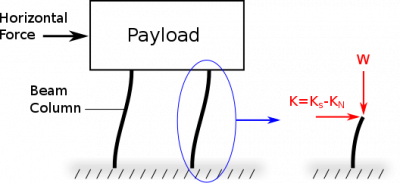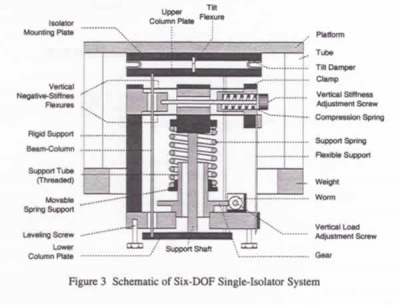Difference between revisions of "Negative-stiffness isolators"
| (4 intermediate revisions by the same user not shown) | |||
| Line 2: | Line 2: | ||
* '''Vertical Motion Isolation:''' | * '''Vertical Motion Isolation:''' | ||
It uses a conventional spring connected to a Negative Stiffness Isolator (NSI) consisting of two bars hinged at the center. The stiffness of the isolator is K=KS-KN where KS is the spring stiffness and KN is the magnitude of a negative-stiffness which is a function of the length of the bars and the load P. | It uses a conventional spring connected to a Negative Stiffness Isolator (NSI) consisting of two bars hinged at the center. The stiffness of the isolator is K=KS-KN where KS is the spring stiffness and KN is the magnitude of a negative-stiffness which is a function of the length of the bars and the load P. | ||
| − | + | ||
* '''Horizontal Motion Isolation:''' | * '''Horizontal Motion Isolation:''' | ||
The beam-columns have horizontal stiffness Ks with the weight load applied laterally. Due to this the lateral bending stiffness is reduced by the "beam-column" effect. This behavior is equivalent to a horizontal spring combined with an NSI so that the horizontal stiffness is K=Ks-Kn, and Kn is the magnitude of the beam-column effect. | The beam-columns have horizontal stiffness Ks with the weight load applied laterally. Due to this the lateral bending stiffness is reduced by the "beam-column" effect. This behavior is equivalent to a horizontal spring combined with an NSI so that the horizontal stiffness is K=Ks-Kn, and Kn is the magnitude of the beam-column effect. | ||
| − | [[File: | + | [[File:NSI2.png|thumb|left|400px|Horizontal motion isolation. Image reproduced from [https://commons.wikimedia.org/wiki/File:Vibrations_damping.svg here]]] |
| + | [[File:NSI6.jpg|thumb|center|400px|Six DOF Single Isolator. Attribution: By Sdv1120 - Own work, Public Domain, https://commons.wikimedia.org/w/index.php?curid=10530707]] | ||
| + | <br \> | ||
---- | ---- | ||
If you are done reading this page, you can go back to [[Transportation#Types of PVI Systems|Types of PVI Systems]] | If you are done reading this page, you can go back to [[Transportation#Types of PVI Systems|Types of PVI Systems]] | ||
| + | |||
| + | == References == | ||
| + | This page has been inspired from https://www.minusk.com/content/in-the-news/Cleanroom_Technology_0412.html | ||
Latest revision as of 11:06, 23 February 2018
- Natural frequency range: 0.17 – 2.5 Hz
- Vertical Motion Isolation:
It uses a conventional spring connected to a Negative Stiffness Isolator (NSI) consisting of two bars hinged at the center. The stiffness of the isolator is K=KS-KN where KS is the spring stiffness and KN is the magnitude of a negative-stiffness which is a function of the length of the bars and the load P.
- Horizontal Motion Isolation:
The beam-columns have horizontal stiffness Ks with the weight load applied laterally. Due to this the lateral bending stiffness is reduced by the "beam-column" effect. This behavior is equivalent to a horizontal spring combined with an NSI so that the horizontal stiffness is K=Ks-Kn, and Kn is the magnitude of the beam-column effect.


If you are done reading this page, you can go back to Types of PVI Systems
References
This page has been inspired from https://www.minusk.com/content/in-the-news/Cleanroom_Technology_0412.html